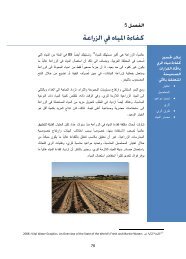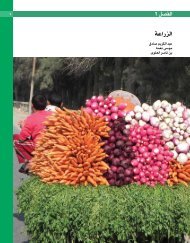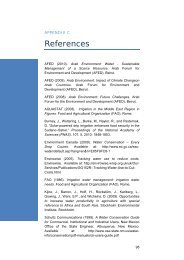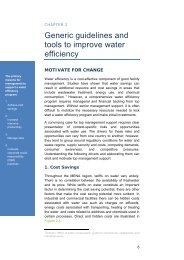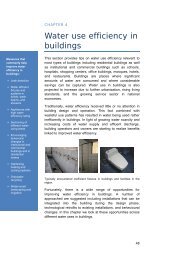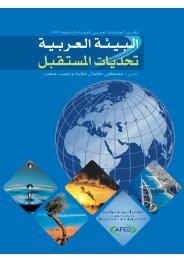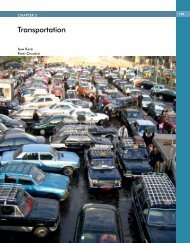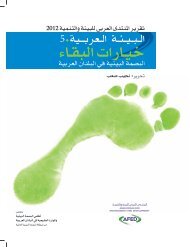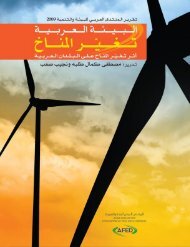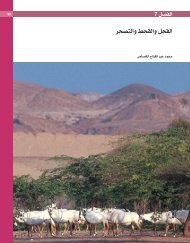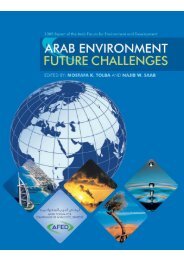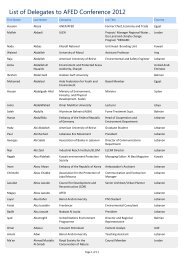Impact of Climate Change on Arab Countries - (IPCC) - Working ...
Impact of Climate Change on Arab Countries - (IPCC) - Working ...
Impact of Climate Change on Arab Countries - (IPCC) - Working ...
Create successful ePaper yourself
Turn your PDF publications into a flip-book with our unique Google optimized e-Paper software.
ARAB ENVIRONMENT: CLIMATE CHANGE 111<br />
outbreak which in turn may be due to the pest<br />
species, the amount <str<strong>on</strong>g>of</str<strong>on</strong>g> genetic variati<strong>on</strong> and<br />
adaptability to current weather c<strong>on</strong>diti<strong>on</strong>s in the<br />
pest populati<strong>on</strong>, predati<strong>on</strong> levels for example by<br />
birds <strong>on</strong> the insects, and whether or not insecticides<br />
have been applied.<br />
<strong>Countries</strong> in the <strong>Arab</strong> regi<strong>on</strong> must design and<br />
implement specific and tailored projects for mitigating<br />
and adapting to climate change. In the<br />
past, species survived previous climate change<br />
events as they were able to track their habitats<br />
though space. Unfortunately, today this is<br />
becoming extremely and increasingly difficult as<br />
humans have transformed or fragmented the natural<br />
world. As such the inhabitants <str<strong>on</strong>g>of</str<strong>on</strong>g> the <strong>Arab</strong><br />
world should deploy significant and immediate<br />
efforts in order to provide species with the possibility<br />
to shift their habitats and adapt to climate<br />
change (Janss<strong>on</strong> and Dynesius, 2002).<br />
In terms <str<strong>on</strong>g>of</str<strong>on</strong>g> protected areas management, there<br />
are two main strategies that should be applied in<br />
a parallel and complimentary manner in order to<br />
ensure maximum c<strong>on</strong>servati<strong>on</strong> coverage and efficiency.<br />
The first strategy is to add new protected<br />
areas to maintain species’ representati<strong>on</strong> targets<br />
and the sec<strong>on</strong>d strategy refers to the management<br />
<str<strong>on</strong>g>of</str<strong>on</strong>g> species within protected areas in reference to<br />
and in coordinati<strong>on</strong> with other protected areas<br />
(and not simply to maintain the site’s status quo)<br />
(Hannah et al., 2002). In the <strong>Arab</strong> world, it<br />
would be <str<strong>on</strong>g>of</str<strong>on</strong>g> significant importance to adopt and<br />
apply three main axes in protected areas planning,<br />
including the expansi<strong>on</strong> <str<strong>on</strong>g>of</str<strong>on</strong>g> protected areas,<br />
managing outside the protected area and regi<strong>on</strong>al<br />
coordinati<strong>on</strong> <str<strong>on</strong>g>of</str<strong>on</strong>g> management acti<strong>on</strong>s (Hannah<br />
et al., 2002).<br />
Last but not least, the <strong>Arab</strong> regi<strong>on</strong> as an interlinked<br />
geographical entity should develop and<br />
implement regi<strong>on</strong>al mechanisms for coordinating<br />
activities in this field. Species range-shifts,<br />
impacts <str<strong>on</strong>g>of</str<strong>on</strong>g> extreme events and resources asynchr<strong>on</strong>ies<br />
<str<strong>on</strong>g>of</str<strong>on</strong>g>ten occur <strong>on</strong> regi<strong>on</strong>al scales so an<br />
effective climate change strategy must include<br />
mechanisms for coordinating c<strong>on</strong>servati<strong>on</strong><br />
acti<strong>on</strong>s at the regi<strong>on</strong>al level across political<br />
boundaries and agency jurisdicti<strong>on</strong> (Hannah et<br />
al., 2002). In order to tackle a global phenomen<strong>on</strong><br />
with impacts <strong>on</strong> many levels and scales,<br />
regi<strong>on</strong>al coordinati<strong>on</strong> is a necessary element for<br />
effective and sustainable results.<br />
REFERENCES<br />
Al-Eisawi, D.M. Report <strong>on</strong> ecosystems and biodiversity.<br />
Unpublished.<br />
Al-Eisawi, D.M. (2008). ’Restorati<strong>on</strong> and Saving<br />
Biodiversity in Desert <str<strong>on</strong>g>Climate</str<strong>on</strong>g>’. 2nd World Scientific<br />
C<strong>on</strong>gress, Challenges in Botanical Research and<br />
<str<strong>on</strong>g>Climate</str<strong>on</strong>g> <str<strong>on</strong>g>Change</str<strong>on</strong>g>. 29 June-4 July 2008. Delft, The<br />
Netherlands.<br />
Al-Eisawi, D.M. (2004). ‘Flora and Vegetati<strong>on</strong> <str<strong>on</strong>g>of</str<strong>on</strong>g><br />
Hawar Islands, Kingdom <str<strong>on</strong>g>of</str<strong>on</strong>g> Bahrain’. <strong>Arab</strong>ian Gulf<br />
University. Manama, Kingdom <str<strong>on</strong>g>of</str<strong>on</strong>g> Bahrain.<br />
<strong>Arab</strong> Forum for Envir<strong>on</strong>ment and Development – AFED<br />
(2008). <strong>Arab</strong> Envir<strong>on</strong>ment, Future Challenges. AFED<br />
Annual Report 2008. N. Saab and M.K. Tolba (Eds.).<br />
Beirut, Leban<strong>on</strong>: Technical Publicati<strong>on</strong>s.<br />
Bakkenes, M. ,J.R.M Alkemade, F. Ihle, R. Leemans,<br />
and J.B. Latour (2002). Assessing effects <str<strong>on</strong>g>of</str<strong>on</strong>g> forecasted<br />
climate change <strong>on</strong> the diversity and distributi<strong>on</strong> <str<strong>on</strong>g>of</str<strong>on</strong>g><br />
European higher plants for 2050. Global <str<strong>on</strong>g>Change</str<strong>on</strong>g> biology.<br />
8: 390-407.<br />
Biomes and Ecosystems (2008). Windows to the<br />
Universe at the University Corporati<strong>on</strong> for Atmospheric<br />
Research (UCAR). ©1995-1999, 2000 The Regents<br />
<str<strong>on</strong>g>of</str<strong>on</strong>g> the University <str<strong>on</strong>g>of</str<strong>on</strong>g> Michigan; ©2000-05 University<br />
Corporati<strong>on</strong> for Atmospheric Research. At:<br />
http://www.windows.ucar.edu/tour/link=/earth/Life/im<br />
ages/biomes_lg_jpg_image.html<br />
C<strong>on</strong>venti<strong>on</strong> <strong>on</strong> Biological Diversity – CBD (2007).<br />
Biodiversity and <str<strong>on</strong>g>Climate</str<strong>on</strong>g> <str<strong>on</strong>g>Change</str<strong>on</strong>g> Biodiversity and<br />
<str<strong>on</strong>g>Climate</str<strong>on</strong>g> <str<strong>on</strong>g>Change</str<strong>on</strong>g>-Internati<strong>on</strong>al Day for Biological<br />
Diversity.<br />
C<strong>on</strong>venti<strong>on</strong> <strong>on</strong> Biological Diversity – CBD. Nati<strong>on</strong>al<br />
Reports. At: http://www.cbd.int/reports/<br />
Currie, D.J. 2001. ‘Projected effects <str<strong>on</strong>g>of</str<strong>on</strong>g> climate<br />
change <strong>on</strong> patterns <str<strong>on</strong>g>of</str<strong>on</strong>g> vertebrate and tree species<br />
richness in the c<strong>on</strong>terminous United States’.<br />
Ecosystems. 4: 216-225.<br />
Eclcy, H. A. C., M. J. Lawes, and S. E. Piper (1999).<br />
‘The influence <str<strong>on</strong>g>of</str<strong>on</strong>g> climate change <strong>on</strong> the distributi<strong>on</strong> <str<strong>on</strong>g>of</str<strong>on</strong>g><br />
indigenous forest in KwaZulu-Natal, South Africa’.<br />
Journal <str<strong>on</strong>g>of</str<strong>on</strong>g> Biogeography. 26: 595-617.<br />
Envir<strong>on</strong>mental Sustainability Index – ESI (2005).<br />
Benchmarking Nati<strong>on</strong>al Envir<strong>on</strong>mental Stewardship.<br />
Yale Center for Envir<strong>on</strong>mental Law and Policy. Yale<br />
University Center for Internati<strong>on</strong>al Earth Science<br />
Informati<strong>on</strong> Network Columbia University.<br />
Hannah I., G.F. Midgley and D. Millar (2002). ‘<str<strong>on</strong>g>Climate</str<strong>on</strong>g><br />
change-integrated c<strong>on</strong>servati<strong>on</strong> strategies’. Global<br />
Ecology and Biogeography. 11: 485-495.<br />
Hickling, R. D. B. Roy, J.K. Hill, R. Fox, and C.D.<br />
Thomas (2006). ‘The distributi<strong>on</strong>s <str<strong>on</strong>g>of</str<strong>on</strong>g> a wide range <str<strong>on</strong>g>of</str<strong>on</strong>g><br />
tax<strong>on</strong>omic groups are expanding polewards.’ Global<br />
<str<strong>on</strong>g>Change</str<strong>on</strong>g> Biology. 12: 450-455.



